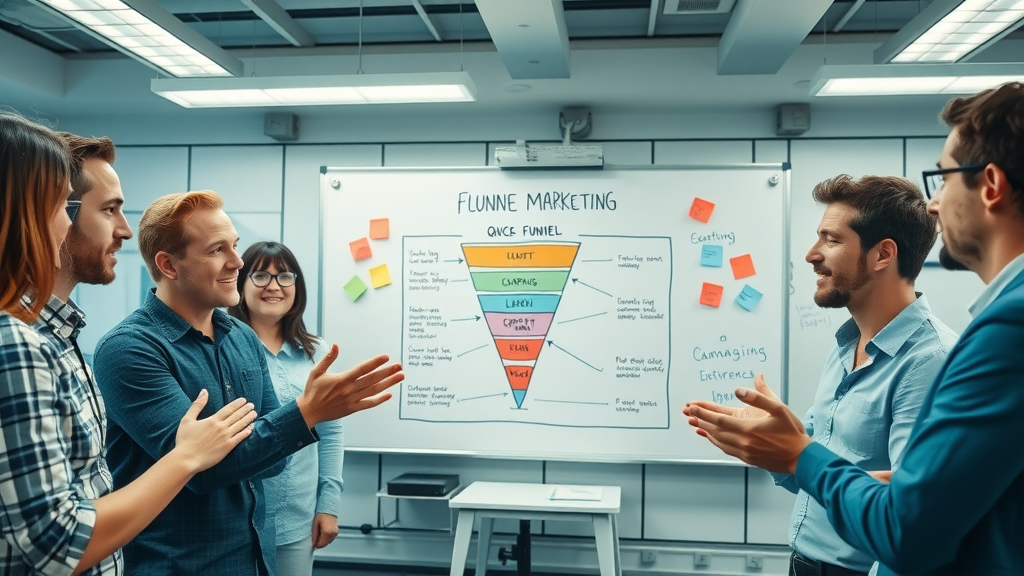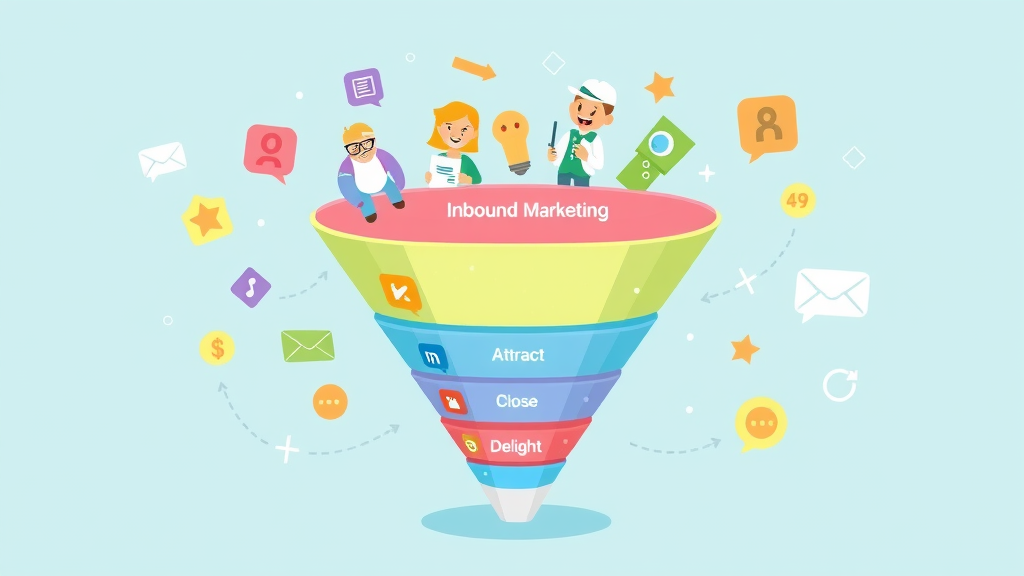Did you know? Businesses that embrace inbound marketing experience up to a 54% greater return on investment compared to traditional methods. In today’s fast-paced digital world, finding new ways to accelerate your company’s growth has never been more important. Inbound marketing may just be the secret strategy you’ve been missing — blending valuable content, precise targeting, and marketing automation to attract ideal customers and build lasting relationships. If you’re ready to transform how you reach and convert audiences, dive into the powerful world of inbound marketing below.

A Surprising Look at Inbound Marketing: Why Now?
In a rapidly evolving digital market, your potential customers are more informed than ever before and demand meaningful engagement, not just flashy ads. Traditional outbound marketing—think intrusive ads, cold calls, and email blasts—is losing its edge. Instead, inbound marketing empowers businesses to draw in highly engaged prospects by offering genuine value through content and tailored experiences. By aligning your brand with your audience’s needs and showcasing your expertise via digital marketing channels, you set the stage for deeper trust, increased brand awareness, and sustained growth.
If your marketing efforts feel less effective than they used to, it’s likely that modern buyers are tuning out outdated tactics. Adopting inbound strategies now sets you ahead of competitors still stuck in the past. The real question is: why wait?
“Businesses that prioritize inbound marketing see a 54% greater return on investment compared to traditional marketing.”
What You'll Learn About Inbound Marketing
- The fundamentals and advantages of inbound marketing
- How inbound marketing strategies outshine outbound marketing
- Key components of an effective inbound marketing campaign
- Role of marketing automation and valuable content in targeting your audience
- Steps to create, launch, and measure inbound marketing strategies
Fundamentals of Inbound Marketing
What is Inbound Marketing?
Inbound marketing is a customer-centric approach focused on attracting potential customers using relevant, valuable content that answers their questions, solves their problems, and enhances brand awareness. Instead of pushing out intrusive ads, you create content—articles, videos, downloads, webinars—to naturally pull interested people toward your brand. At its core, inbound marketing leverages search engine optimization (SEO), content marketing, and social media to help your business become a trusted source in your industry.
By nurturing leads through every stage of their buyer’s journey, inbound marketing increases your visibility and conversion rates over time. This method not only attracts more qualified leads but also bolsters lasting relationships with your target audience, all while being cost-effective compared to outbound marketing methods.
The Philosophy Behind Inbound Marketing vs Outbound Marketing
Traditional outbound marketing methods—such as TV ads, cold calls, and direct mail—interrupt potential customers and often feel intrusive. In today’s digital landscape, these tactics are met with resistance as users filter out “noise.” In contrast, inbound marketing strategies seek to attract customers organically by providing quality content that addresses their specific interests and concerns. Rather than chasing your prospects, you become a magnet, pulling them to your digital doorstep through strategic content creation and targeted outreach.
This shift to an inbound approach empowers businesses to build trust, nurture leads, and foster lasting relationships in a manner that feels genuine and mutually beneficial. As a result, inbound marketing offers higher lead generation rates, improved return on investment, and greater customer loyalty.
Key Pillars: Valuable Content and Lasting Relationships
Every successful inbound marketing campaign is built on two key foundations: the ongoing creation of valuable content, and the cultivation of strong, lasting relationships. High-quality, relevant content turns curious browsers into engaged prospects, establishing your brand as a go-to resource for industry knowledge. Effective content creation—whether blog posts, guides, videos, or social media—positions you to address your audience’s pain points and answer the questions they’re searching online.
Beyond content, nurturing lasting relationships with your target audience is essential for long-term growth. This means consistent email marketing, personalized responses, and using marketing automation tools to deliver relevant messages at the right time. Together, these pillars ensure that your inbound marketing not only attracts new business, but turns those prospects into loyal, recurring customers.

How Inbound Marketing Drives Growth
Inbound Marketing Strategy: Aligning with Your Target Audience
The secret to explosive growth via inbound marketing lies in truly understanding and connecting with your target audience. It’s about identifying their unique needs, pain points, and motivations, then crafting messages and campaigns that speak directly to them. By strategically researching and developing detailed buyer personas, your marketing campaign becomes laser-focused, ensuring every piece of content resonates with a specific segment.
A tailored inbound marketing strategy leverages data from your website analytics, social media interactions, and marketing research, so you meet your prospective customers where they are—delivering information, offers, and resources they can’t resist. This level of alignment between your business and your audience dramatically enhances lead generation and forms the backbone of any successful inbound marketing approach.
The Role of Search Engine Optimization in Inbound Marketing
Search engine optimization (SEO) is the fuel that powers your inbound marketing engine. By optimizing your site and quality content for relevant keywords and topics, you boost your chances of appearing at the top of search results where your potential customers are looking. Effective SEO doesn’t just bring in traffic—it brings in targeted, qualified visitors who are ready to convert.
SEO is more than choosing the right words. It’s about leveraging technical best practices, keeping content updated, and ensuring your website delivers a great user experience on all devices. When integrated with content creation, strong SEO places your business front and center and rapidly expands your digital footprint to attract a steady flow of leads through organic search.
Creating Content that Converts and Attracts
Outstanding inbound marketing revolves around expertly creating content that solves problems, educates, and delights your target audience. Whether you’re publishing blog articles, shooting videos, or developing downloadable guides, effective content isn’t just noise—it’s highly relevant and action-driven. The goal? Move prospects down the funnel, from awareness to decision, with nurturing touchpoints at every stage.
Smart content marketers use a mix of educational blogs, engaging social media, compelling case studies, and irresistible calls-to-action. When combined with advanced marketing automation, each piece of content is delivered to the right audience at the right time for maximum impact—turning casual readers into loyal customers.
Comparison: Inbound Marketing vs Outbound Marketing
| Aspect | Inbound Marketing | Outbound Marketing |
|---|---|---|
| Method | Attracts with valuable content and organic engagement | Interrupts with ads, cold calls, and email blasts |
| Audience | Targets specific buyer personas and needs | Targets broad audiences, less personalized |
| Cost | Lower, long-term investments (content, SEO, automation) | Higher, recurring costs (ad spend, direct mail, media buys) |
| Lead Generation | Attracts warm, qualified leads; higher conversion | Reaches cold leads; lower conversion rate |
| Relationship | Focuses on building lasting relationships | Limited engagement post-interaction |
Building Your Inbound Marketing Campaign
Step 1: Define Your Target Audience
Every successful inbound marketing campaign begins with a deep understanding of your target audience. Develop detailed buyer personas using real data and insights about your ideal potential customers—demographics, pain points, goals, media habits, and more. This laser-sharp targeting allows you to focus your content creation and promotional efforts where they’ll have maximum impact, saving resources while boosting results.
Targeting the right audience ensures your messages speak directly to the people most likely to convert, turning cold strangers into loyal fans. Skipping this step is the biggest reason why many inbound strategies fail to launch.
Step 2: Develop an Inbound Marketing Strategy
Armed with detailed personas, it’s time to build your inbound marketing strategy. Map out the topics, keywords, channels (blog, SEO, email, social media), and content types your audience prefers. Set specific goals for brand awareness, lead generation, and customer retention. Outline a content calendar, integrating social media marketing and automation tools to optimize delivery.
Strategically blend content creation with marketing automation for nurture flows, and always plan for regular analysis and adjustments. A well-structured inbound strategy anticipates your prospects’ questions and continuously adapts to shifting trends.
Step 3: Creating Content for Every Stage of the Funnel
Not all prospects are at the same stage of their journey. Create quality content tailored to every step: awareness (educational resources, blog posts), consideration (case studies, product comparisons), and decision (free trials, demos, testimonials). This ensures you’re moving leads further down the funnel with the right information at the right time.
Content should solve specific problems, demonstrate value, and include strategic CTAs (calls-to-action) to capture leads or drive engagement. Smart marketers also repurpose high-performing content across email marketing, social media, and other platforms for maximum ROI.

Step 4: Launch and Optimize Your Marketing Campaigns
With all the elements ready, launch your inbound marketing campaigns across chosen channels. Track key metrics from the start—traffic, conversions, engagement, and more. Analyze results frequently, using data to identify what’s working and where you can improve.
Optimization is a continual process: adjust your content, SEO tactics, email marketing workflows, and social media approaches for better alignment with your target audience. The more you measure and refine, the stronger your campaigns will become over time.
Step 5: Using Marketing Automation to Scale Results
Marketing automation is a game-changer for scaling your inbound marketing efforts. With automation tools, you can segment audiences, schedule campaigns, nurture leads, and personalize follow-ups without manual labor. Workflows, drip emails, and trigger-based messaging deliver consistent, timely value to each prospect.
As your inbound strategy grows, automation makes it possible to manage larger volumes of leads while maintaining relevance and personalization. This technology allows you to scale growth and build loyalty faster, turning prospects into advocates.
Four Stages of Inbound Marketing Explained
- Attract: Draw in the right people with valuable content, SEO, and strategic social media.
- Convert: Turn visitors into leads with strong CTAs, landing pages, and optimized forms.
- Close: Nurture and educate leads through email marketing and automation until they become customers.
- Delight: Deliver exceptional service and content to turn customers into loyal promoters of your brand.

Top Inbound Marketing Strategies for Fast Growth
- SEO-driven blogging
- Email nurturing sequences
- Lead magnets and landing pages
- Webinars and value-based video content
- Social media content repurposing
Measuring Success: Analytics and KPIs for Inbound Marketing Campaigns
Measuring and tracking performance is crucial for maximizing your marketing campaign ROI. Analytics dashboards and key performance indicators (KPIs) give you insights into what’s working, where to invest more, and where to pivot. Regularly monitoring website traffic, conversion rates, lead sources, and customer retention rates allows you to fine-tune your inbound marketing for optimal results.
An advanced analytics setup lets you tie activity—like social media marketing or email marketing—directly to business outcomes. Integrate tools like Google Analytics, CRM systems, and marketing automation dashboards to get a holistic view of performance and progress.
Key Performance Indicators for Marketing Campaign Success
KPIs for inbound marketing include website visitors, bounce rates, lead conversion rates, customer acquisition cost, email open/click-through rates, and social engagement. Track which blog posts or campaigns generate the highest engagement and adjust your marketing strategies for even greater success.
Set benchmarks and compare performance over time. Use actionable data to increase sales velocity and create a cycle of continuous improvement—making your inbound approach more effective with every iteration.

Busting Myths: Common Misconceptions about Inbound Marketing
Many still believe that inbound marketing is only about blogging or attracting random website traffic. In reality, inbound is a full-funnel, holistic approach that nurtures buyer relationships and moves leads from awareness to advocacy. Another myth is that inbound takes too long to show results; however, with a targeted marketing strategy, clear measurement, and smart marketing automation, strong ROI can come quickly.
"Inbound marketing isn’t just about attracting leads; it’s about building lasting relationships that drive repeat business."
Lastly, some worry inbound is only for tech companies or large enterprises, but the truth is any business seeking to elevate brand awareness, drive consistent lead generation, and foster trust can succeed with inbound.
People Also Ask: Answers to Common Inbound Marketing Questions
What is meant by inbound marketing?
Inbound marketing refers to a strategy that attracts customers by creating valuable content and experiences tailored to them, drawing them in rather than interrupting with outbound messages.
What is inbound vs outbound marketing?
Inbound marketing focuses on attracting prospects via valuable content and interactions, while outbound marketing interrupts prospects with traditional ads, cold calls, or email blasts.
What are the four stages of inbound marketing?
The four stages are Attract, Convert, Close, and Delight—each designed to move leads from stranger to customer to advocate.
What are the 4 methods of marketing?
The four main methods of marketing commonly known as the marketing mix are Product, Price, Place, and Promotion—with inbound marketing strategies integrating all four.
Frequently Asked Questions about Inbound Marketing
How does inbound marketing use search engine optimization?
Inbound marketing leverages search engine optimization (SEO) to increase your website’s visibility, making it easier for potential customers to find your content when they search online. By optimizing content with the right keywords and creating valuable resources, you attract organic traffic and convert visitors into leads.
Why is valuable content important in inbound marketing?
Valuable content is the cornerstone of inbound marketing because it offers answers, solves problems, and provides insight to your target audience. High-quality, relevant content builds trust, improves engagement, and encourages visitors to return—ultimately helping convert leads into customers and advocates.
What types of businesses benefit most from inbound marketing?
Inbound marketing benefits a wide range of businesses—from B2B and SaaS to retail and local services. Companies seeking to build long-term customer relationships, improve lead generation, and increase brand awareness gain the most from adopting inbound strategies.
How can marketing automation boost inbound performance?
Marketing automation streamlines repetitive tasks, such as lead nurturing, segmentation, and follow-up, enabling businesses to deliver timely and personalized messages at scale. This technology helps maintain consistency, increases engagement, and frees up marketers to focus on strategic planning and content creation.

Key Takeaways: Inbound Marketing for Accelerated Success
- Inbound marketing puts your business in front of highly engaged audiences
- Valuable content and search engine optimization drive sustainable growth
- Marketing automation enhances consistency and results
- Measuring KPIs is crucial for continuous improvement
Conclusion: Start Your Inbound Marketing Journey
Unlock rapid business growth by implementing a data-driven inbound marketing strategy that attracts, engages, and delights your audience.
 Add Row
Add Row  Add
Add 




Write A Comment